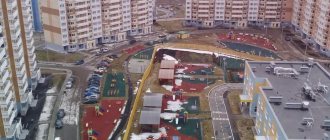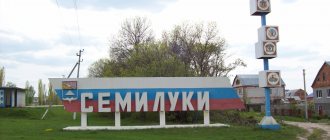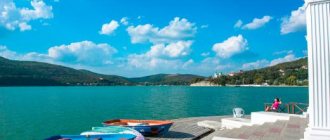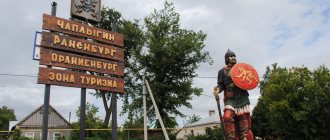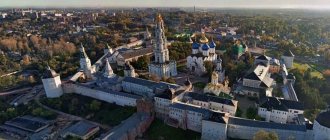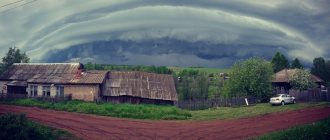Perm is a city in the Urals, the administrative center of the Perm region. It stands on the banks of the large Kama River, below the mouth of the Chusovaya River. Perm stretches along the Kama River for as much as 65 km and in terms of area (800 sq. km) it is the fourth city in Russia (after Moscow, St. Petersburg and Volgograd). Population – 1.05 million people. From 2004 to 2012, the population fell below 1 million inhabitants.
The name of the city is pronounced with a soft “r”. This is contrary to the rules of the Russian language, but this is how it happened historically. Thanks to this feature, local residents can easily distinguish visitors who are not aware of this feature. The word "Perm" was first mentioned in the Tale of Bygone Years in 1113. It is believed that it came from the Finnish-Karelian words “perya maa” - back (distant) land. Until the 18th century, the toponym was used to designate certain territories (Perm the Great, Perm Vychegda), where the Komi people lived.
Perm is a pleasant city with friendly people and a developed culture. In the recent past, they wanted to turn Perm into the cultural capital of Europe. After the change of power, the initiative was curtailed (what a pity!). Nevertheless, Perm remains the city in the Urals with the richest cultural life; many interesting festivals are held here.
General information and history of Perm
Modern Perm is a large industrial center in the east of the European part of Russia and the third largest city in the country after Moscow and St. Petersburg (799.68 sq. km).
Historically, the city-forming axis of Perm is the Kama River, a tributary of the Volga and the main river of the Western Urals. Along the Kama banks the city stretches for 70 km, second in length only to St. Petersburg and Sochi.
Photo by Samisusami (https://fotki.yandex.ru/users/akustov18/)
Perm is one of the largest industrial centers in the country. The leading sectors of the city's economy are mechanical engineering, oil and gas refining, electric power, chemistry and petrochemistry, food industry, woodworking and printing.
The intersection of transcontinental roads, railways and air lines make Perm a significant transport hub and logistics center of the Urals. The Kama is the fifth longest river in Europe. The waterway along the Kama will take you in the direction of the five seas - Azov, Black, Caspian, White and Baltic. Motorists can get to Perm along the Moscow-Chita federal highway. Bolshoye Savino International Airport provides regular air transportation within Russia and abroad, and has border and customs services.
The territory of modern Perm has been inhabited by humans since ancient times, as evidenced by the finds of archaeological sites from the Stone Age to the late Middle Ages. The name of the city is associated either with the modified word “Parma” - “a hill covered with a spruce forest”, or is translated from the language of the Vesi people “Pere Maa” as “distant land”.
The birth of the city is associated with the discovery of copper ore deposits at the confluence of the Kama and Yegoshikha rivers. Built on the site chosen by the famous geographer and historian Vasily Nikitich Tatishchev in 1723, the copper smelter and the settlement around it became a starting point in the history of Perm. The decree on the creation of the provincial city of Perm here was signed by Catherine II in November 1780.
Three years later, the city’s coat of arms, which has survived to this day, was approved - a silver walking bear (the most revered animal among the Komi people) is depicted on a red field - a symbol of the natural resources of the region. On its back the bear carries the golden Gospel - a symbol of enlightenment that came here with Christian culture. The heraldic shield is crowned with a cross.
Orsk | 621 sq. kilometers
Orsk , which includes three administrative districts with an area of about 621.33 square meters. kilometers, takes seventh place in the list of the largest Russian cities. It is located in a picturesque place - on the spurs of the majestic Ural Mountains, and the Ural River divides it into two parts: Asian and European. The main industry developed in the city is industry. There are more than 40 archaeological sites in Orsk.
Climate and ecology of Perm
The climate of Perm is temperate continental. The increased humidity is due to its location on the river and the proximity of the Kama Reservoir. A special feature of the geography of Perm is the presence of small rivers flowing within the city in ravines, and a huge number of urban forests that occupy a significant part of the city territory (almost 400 sq. km) and significantly improve the ecology of a large industrial center.
Snowy long winter with an average temperature of -15 -20 C. Moderately warm summer within the temperature range of +18 +23C.
The peculiarities of the climate of the Perm region include fairly frequent thunderstorms, fogs and snowstorms and inconsistent weather conditions (spring returns of cold weather, frosts in early summer, hail and summer showers).
Rainfall in Perm in 2011
The well-developed industry of the region and the presence of large enterprises determine the environmental problems of the region, the causes of which are both man-made pollution and insufficient environmental management.
The main sources of air pollution in Perm are emissions from industrial enterprises, to which increased vehicle emissions have been added in recent years with the growth of the vehicle fleet. Water bodies are polluted mainly due to the discharge of industrial wastewater.
By district of the city, emissions of pollutants into the atmosphere are distributed in the following order: Industrial (about 50%), Ordzhonikidze (about 20%), Sverdlovsk and Kirov (about 10% each), Dzerzhinsky and Motovilikha (about 4%) and 1% in Leninsky .
The solution to the problem is the modernization of production, which makes it possible to eliminate the threat of harmful emissions without loss of production capacity (carried out, for example, by the Perm Scientific and Production Instrument-Making Company, which produces navigation systems).
Photo by Igor Lugovoy
One of the problems of Perm is the presence of ticks in the forested areas of the city - carriers of tick-borne encephalitis. To protect the population, urban forests and park recreation areas are annually treated with special compounds, and medical institutions vaccinate against the disease.
Environmental projects with the participation of city enterprises and volunteers made it possible to clean more than 20 km of the banks of the city’s small rivers, improve parks and recreational areas, and plant hundreds of trees.
Tyumen | 698 sq. kilometers
In sixth place among the largest settlements in Russia is the first Russian city founded in Siberia - Tyumen. The number of inhabitants is about 697 thousand people. Territory – 698.48 sq. kilometers. Founded in the 16th century, the city now includes 4 administrative districts. The beginning of the future city was laid by the construction of the Tyumen fort, started by decree of Fyodor Ivanovich, the third son of Ivan the Terrible.
Population of Perm
Perm is a city with a population of one million, represented by more than 100 nationalities. As of January 1, 2014, the city's population was 1,026,477 people. Perm is the only city in the country that has twice received the title of millionaire city. The city's population grew throughout the twentieth century and was primarily associated with the development of industry in the region.
The results of the first All-Union Population Census of 1926 showed that 84,804 people lived in Perm. The result of the industrialization carried out in the country was an increase in the number of Perm residents more than threefold - the pre-war census of 1939 already counted 306 thousand citizens.
Photo by Igor Lugovoy
Stable population growth continued in the post-war years, and Perm became one of the largest cities in the country with a population of more than one million people in 1979. Over the next decade, the city's population grew.
The dynamics of the number of Perm residents changed with the collapse of the country. Since the 1990s, the city's population has gradually declined. At the same time, Perm became one of the few large cities where, instead of growth, there was a stable population decline in the 2000s. Already in 2003, Perm lost its status as a city with a population of one million.
A gradual increase in city residents began to be observed in 2011. And finally, at the beginning of 2012, Perm regained its status as a millionaire city. The demographic situation in Perm in 2011 showed natural population growth for the first time in a long time. Although slightly, the birth rate increased - by 0.6%, with a more noticeable decrease in mortality - by 4.2%.
The increase in the number of residents is associated not only with a natural increase in the birth rate, but also with a high migration increase, which in 2011 amounted to about 9 thousand people. The new system for registering migrants registered in the city for a long period (more than nine months) also played a role. Such a “stay” often lasts for years and cannot be ignored in the overall population indicator.
Today, the national composition of the inhabitants of Perm and the region is distributed (based on the results of the All-Russian population census of 2010) as follows: the most numerous - more than 85% - are the Russian population, about 5% are Tatars, more than 3% are Komi-Permyaks, from 0.2 % to 1.5% are Bashkirs, Belarusians, Mari, Germans, Ukrainians, Udmurts and Chuvashs.
Photo by Igor Lugovoy
In terms of age, the city's population predominantly consists of men and women of working age, represented in almost equal numbers; there is an increase in the birth rate; among people of non-working age, women predominate over men.
Among the characteristics of the residents of Perm, one can note a high level of education, due to the presence of a large number of higher educational institutions, including more than ten with long traditions - Perm State University - PSU, Perm State Medical Academy named after. Academician E.A. Wagner - PGMA, Perm State Pharmaceutical Academy - PGFA, Perm State Technical University - PSTU, Perm State Agricultural Academy named after. Academician D.N. Pryanishnikova, Perm State Pedagogical University - PSPU.
Photo by Igor Lugovoy
A distinctive feature, expressed more in the region than in the city itself, is the special dialect of Permians, an example of which anyone can watch in the first comedy series of the TNT channel “Real Boys” filmed entirely in Perm. By the way, many KVN teams from the city’s universities participate in it.
Where to go with children
If you decide to go on a trip with the whole family or don’t know where to go on the weekend with children, we suggest you familiarize yourself with the list of places where you can have fun and interesting time for both adults and the youngest visitors.
Museum of Perm Antiquities
This place is of interest not only for children, but also for adults. By booking a tour, you will learn a lot about how they used to live in Perm, and all the most fascinating and unusual things about the history of the city.
Amusement park "Balakovo"
Balakovo Park hosts various active events that children will definitely enjoy. In addition, the large area of the park will allow you to run around or enjoy pleasant long walks.
Museum "Motovilikha Plants"
In the Motovilikha Plants Museum you will learn everything about the military industry, tanks and guns.
Perm Zoo
At the Perm Zoo you can see rare species of animals that are listed in the Red Book. Children will be very interested in meeting the inhabitants of this place, and you can even feed some of the animals.
Perm Planetarium
Children who love space can be delighted with a trip to the planetarium. Here you can see stars, comets, planets and the Milky Way with your own eyes. Not only children, but also parents will be delighted with what they see. Visiting such places broadens your horizons, which means your time will be spent usefully.
Extreme Park
You can’t leave Perm without visiting the Extreme Park. Children who need constant movement will calm down after visiting, splashing out all their energy on the attractions. Their huge variety will satisfy the needs of even the most demanding visitors. You and your children will be impressed for a long time.
Districts and real estate of Perm
City map. Districts of Perm
The city-forming axis of Perm is the Kama River; the city itself is divided into left-bank and right-bank parts. The historical and now modern administrative, business and cultural center of the city is located on the left bank of the river. There are also architectural monuments, cultural centers and museums, cathedrals and temples.
The wide, flat space of the left bank of Perm has a regular layout, wide squares and central thoroughfares. Almost half of the city's territory is occupied by urban forests and recreation parks.
There are seven large urban districts in Perm: Leninsky, Ordzhonikidze, Dzerzhinsky, Kirovsky, Industrialny, Sverdlovsky and Motovilikha.
The most popular residential areas for living are located in the Leninsky, Sverdlovsky, Motovilikha and Dzerzhinsky districts of the city.
Leninsky district
The smallest central district of Perm in terms of area and most significant in terms of cultural, scientific and business potential. Leninsky district is located in the historical center of the old city on both banks of the Kama River, occupying 47.5 square meters. km. From north to south, the territory of the district stretches for 6 km. The main part of the region is southern, left bank. An important transport hub is located here – the River Station.
The population of the district is 48.5 thousand people. Representative offices of government agencies, educational, scientific and cultural institutions, and industrial enterprises are located in seven microdistricts.
The region has more than 10 thousand different enterprises, the largest representing the fuel and energy complex, mechanical engineering and food industry: LLC LUKOIL-Permneft, Russian Railways branch Permsky MRZ, Perm Telephone, Permavtodor, First Bread. On the territory of the district there is a central market, the main post office, Central Department Store, and large shopping and entertainment complexes. The transport network is well developed. Healthcare is represented by central city and regional hospitals and clinics.
Leninsky district ranks first in the number of higher educational institutions. Pharmaceutical, medical and agricultural academies, institutes of arts and culture, railway transport, a technical university, a branch of the Russian Academy of Painting, Sculpture and Architecture provide applicants with a wide choice of future professions.
Opera and Ballet Theatre. Permian
Leninsky district is also the center of cultural life in Perm. There are museums and libraries, exhibition halls and galleries, a philharmonic society, and theaters here. Here, lovers of classical and contemporary art can visit exhibitions, performances and art projects of international level.
As you may have guessed, the Leninsky district is the most prestigious area of the city, as evidenced by the highest real estate prices. True, we must remember that we are talking about the left bank part of it. The most expensive multi-storey construction, a small sector of cottage houses, luxury new buildings - for the right price.
New building in Leninsky district
Real estate prices in the historical, cultural and business center of Perm are expected to be the highest in the city. The supply price for apartments on the primary market in the Leninsky district is 59.35 TR/sq.m, on the secondary market - 56.97 TR/sq.m.
Ordzhonikidze district
It occupies 22% of the city's territory, located on both banks of the Kama. The area is 178.5 km2, of which about 40 km2 is built up, which is 22% of the entire territory. Area of private residential development, garden plots and industrial enterprises.
The Ordzhonikidze district is largely an industrial sector of the city and an area of predominantly private residential sector, which makes up a quarter of all development. The population is about 113 thousand people living in 11 microdistricts. At the same time, the Chusovoy microdistrict is located 30 km from the city center, and the Malye Reki microdistrict consists of three cottage villages.
The industry is represented by large enterprises: Kamskaya HPP, NPO Iskra, Uralhydrostal, Kamkabel. Despite the large industrial areas, the area is quite “green”, there are park areas and recreation areas, and there are over a hundred gardening associations located here.
The infrastructure of the district includes educational institutions - kindergartens, schools, gymnasiums, lyceums, art schools; medicine – clinics and inpatient treatment units; culture and sports. There are three sports schools, halls, two stadiums – “Gaiva” and “Molniya”, two yacht clubs.
The housing stock of the Ordzhonikidze district as of March 1, 2012 is 4,355 houses. Among them are 850 apartment buildings and 3,505 private houses. In 2011, 8 high-rise buildings were put into operation.
Ordzhonikidze district of Perm
It should be noted that the distance from the city center and difficulties with transport links in the Ordzhonikidze district microdistricts are not a priority when purchasing housing. In this regard, real estate prices here are more affordable than in other areas of the city. The supply price for apartments on the primary market in the Ordzhonikidze district is 33.54 TR/sq.m, on the secondary market - 38.74 TR/sq.m.
House on Chernyakhovskogo, 49
Dzerzhinsky district
The area of the district is 64.2 square meters. m., population about 150 thousand people. The area is rightfully considered the transport gateway of Perm; the Perm-2 and Perm-Sortirovochnaya railway stations, the Port of Perm and the Zaostrovsky cargo terminal are located here. At the same time, the Dzerzhinsky district is the center of the city’s scientific life; it is here that Perm State University is located. The city-forming enterprise of the district is the Machine-Building Plant named after. F.E. Dzerzhinsky.
Permian. Dzerzhinsky district
The area is actively under construction, with a large number of modern high-rise buildings, developed infrastructure and a good transport network. There are many park areas equipped for recreation, a large territory of the Chernyaevsky forest. Qualified medical care is provided by clinics and hospitals, educational services are provided by kindergartens, schools, lyceums, technical schools, colleges and universities.
The most prestigious in terms of real estate are the Center 2 microdistricts with elite multi-storey buildings, Parkovy, Svetly and Danilikha. The supply price for apartments on the primary market in the Dzerzhinsky district is 46.69 TR/sq.m, on the secondary market – 52.01 TR/sq.m.
Industrial district
The third largest population - about 160 thousand people live here - the Perm region occupies almost 10% of its area: 69 sq. km. Two airports - Barakharevsky for local airlines and Bolshoye Savino, which operates international flights, make the area the “air gateway” of the city.
Already in the name of the district one can feel the power of large industrial enterprises located in the south-eastern part: OJSC Mineral Fertilizers, LLC Lukoil, CJSC Sibur-Khimprom, LLC Spetsneftetrans.
13 microdistricts are located on the left bank of Perm and do not have access to the Kama. One of the small city rivers, Mulyanka, flows through the area. A large green area is represented by the Chernyaevsky Forest recreation park. A popular recreation spot is the city hippodrome.
Good transport links are provided by the central highways of Mira and Sviyazeva streets, Kosmonavtov Highway, Dekabristov Avenue.
For purchasing real estate, the most convenient and popular neighborhoods are those located closer to the city center: Balatovo, Eranichi, Nagorny. The construction of multi-apartment residential buildings is actively underway here. Thus, in July 2012, a residential building with 127 apartments with a total area of 6,190.10 square meters was put into operation. m on Ippodromnaya street. The construction was carried out within the framework of the “People's Apartment” program with the improvement of the adjacent territory and the established infrastructure.
The supply price for apartments on the primary market in the Industrial District is 44.2 rubles/sq.m, on the secondary market – 51.42 rubles/sq.m.
Kirovsky district
The greenest of the city's districts, its area of 156 sq. km is three-quarters occupied by urban forests and forest parks. The population is about 150 thousand people living in 10 microdistricts. There are 16 chemical and mechanical engineering enterprises in the area, including Perm Powder Plant and Sudo.
Medical care is provided by several adult and children's hospitals and clinics. Education is mainly represented by preschool and secondary general education institutions, and several sports schools. The district is decorated with architectural monuments of the 19th century and the specially protected natural area Sosnovy Bor.
Residential real estate in the Kirovsky district is not particularly popular due to its distance from the center and significant problems with transport links with other urban areas. But housing prices here are much more affordable. The supply price for apartments on the primary market in the Kirovsky district is 37.10 rubles/sq.m., on the secondary market – 42.92 rubles/sq.m.
Motovilikha district
A large district of Perm, covering an area of 171.5 square meters. km and includes 17 microdistricts with a population of about 180 thousand people. A special feature of the area is the close interweaving of urbanized urban development with large green forests. The private residential development sector is significant here, but since the mid-1990s, the formation of blocks of modern multi-apartment buildings has begun.
Here is the main city-forming enterprise of Perm - OJSC Motovilikha Plants, a developer and manufacturer of weapons systems, tracked and automotive special equipment, and various equipment. The area is becoming another center of not only industrial, but also cultural life of the city. There are a circus, a planetarium, and museums here.
The infrastructure is represented by healthcare institutions - hospitals, clinics, education - institutes, colleges, schools, about 30 schools and more than 30 preschool institutions.
Some Motovilikha microdistricts occupy leading positions in the popularity rating of residential real estate in Perm. In 2000, construction began on the new Iva microdistrict. The Gorki microdistrict, although located closer to the city center, is inferior to new buildings in the quality of housing; there are mainly Soviet “Khrushchev” buildings here. The greatest demand is for residential real estate in the Sadovyi microdistrict, which is being actively developed with new multi-apartment buildings. The remaining microdistricts of Motovilikha are much inferior in the real estate category.
Permian. Microdistrict Sadovy
The supply price for apartments on the primary market in the Motovilikha district is 44.52 t.r./sq.m., on the secondary market – 51.03 t.r./sq.m.
Sverdlovsk district
The largest district of Perm, Sverdlovsky occupies an area of 122.34 square meters. km and consists of 13 microdistricts. More than 200 thousand people live in it. Unlike other areas of the city, there are no large green forests familiar to Perm residents; almost the entire territory is inhabited. The city’s central thoroughfare, Komsomolsky Prospekt, or Kompros, runs here, dividing the area into western and eastern sides.
Permian. Sverdlovsk region. Photo by V. E. Zarovnyannykh
A popular area for those wishing to purchase an apartment. More than 1,200 houses with a total area of 3.6 million square meters are in unprecedented demand among Perm residents. Here you can choose suitable housing both in elite high-rise buildings and in apartment buildings built according to improved Soviet designs, buildings with economy-class apartments and spacious apartments in new buildings. The most prestigious microdistricts are Center, Sverdlov, Gromov and Ostrovsky. The outskirts of the Sverdlovsk region are already experiencing all the “delights” of being remote from the center - lack of public transport and traffic jams, failures of utility lines.
The main industrial enterprise of the region remains JSC Perm Motors; enterprises of the mechanical engineering, aviation and food industries are widely represented. Numerous healthcare institutions, the city's leading universities and numerous cultural centers and monuments make the area the real heart of a huge city. Well, fans do not miss a single match of their favorite Amkar team, held at the Zvezda stadium.
The striking attractions of the area are the central garden named after. M.I. Gorky with a rotunda built in 1842, the Spaso-Preobrazhensky Cathedral and the monument to Nicholas the Wonderworker above the Kama embankment. It was at the feet of Nikolai Ugodnik that the infamous “crazy bus” slowed down in 2009.
Cathedral and monument to Nicholas the Wonderworker
The supply price for apartments on the primary market in the Sverdlovsk region is 51.45 t.r./sq.m., on the secondary market – 52.33 t.r./sq.m.
Voronezh | 596 sq. kilometer
In 9th place in the top 10 largest Russian cities is Voronezh with an area of 596.51 square meters. kilometer The population is 1.3 million inhabitants. The city is located in a beautiful place - on the banks of the Don and the Voronezh reservoir. Voronezh has many beautiful architectural monuments, but it is also famous for its modern art. Sculptures of the kitten from Lizyukova Street, a character from the famous cartoon, and White Bim from the film “White Bim, Black Ear” were installed in the city. There is also a monument to Peter I in Voronezh.
City infrastructure
The tasks of the city's housing and communal services are determined by the relationships between tenants and management companies of various forms of ownership, homeowners' associations, and housing cooperatives. The management of apartment buildings is primarily carried out by 80 management companies.
Tariffs for utility bills depend on the management company and vary depending on the season; the average for the city is the following figures (including VAT):
- Cold water supply – from 21 rubles/cub.m to 24 rubles/cub.m
- Water disposal - from 13 to 15 rubles / cubic meter
- Hot water supply - from 75 rubles/cub.m to 112 rubles/cub.m in different management companies
- Heating – from 800 to 1300 rub/Gcal
- Electricity - up to 2 rubles/kWh in houses with electric stoves and 2.5-2.6 rubles/kWh in houses with gas stoves
- Gas supply is 3.5-4 rubles/cub.m depending on the season.
- Payment for the maintenance of residential premises – 10-16 rubles/1 sq.m. total area of housing (depending on the number of floors and amenities of the building).
The main problems of housing and communal services in Perm are:
- insufficient funding for capital repairs of municipal infrastructure and housing stock;
- general reduction in housing construction;
- low affordability of housing for citizens with low and middle incomes;
- the need for significant investments to solve problems in the housing sector.
The road network of Perm is characterized by a regular layout in the center and less regularity of blocks and streets on the outskirts. Road traffic is moderately intense, with public transport making up a significant portion of it. Among the shortcomings, one can note the lack of main roads to the outskirts of the city and a smaller number of public transport routes leading to them. In recent years, as throughout the country, there has been an increase in the number of individual vehicles, and as a result, increased traffic intensity, leading to traffic jams on the main city highways during rush hours.
Traffic jam on Kompros
The composition of urban transport is represented by 1025 buses, 197 trams and 120 trolleybuses. Passenger transport transports citizens along 73 bus, 11 tram and 9 trolleybus routes. The uniform tariff for all types of passenger transportation by public transport is 12 rubles. Additionally, there are minibus taxis transporting citizens in 12 directions. The fare for them is slightly higher – 15 rubles. The service is carried out by Permgorelectrotrans and several private carriers.
In 2010-2011, a third of Perm's trolleybus fleet was updated, and 46 new low-floor trolleybuses appeared in the city.
The expansion of rail transport has been declared a priority direction in the development of transport services in accordance with the General Plan for the City Development. As part of the special project “Perm Tram”, 45 new low-floor trams were purchased in 2011.
Perm tram
Newcomers to the tram fleet are distinguished by their bright orange color, low floor, especially convenient for parents with strollers and people with limited mobility, and the presence of wi-fi Internet.
Stopping points have been updated in the central areas of the city. Sketches of the new bus stop pavilions were developed by the Perm Design Center.
Volgograd | 859 sq. kilometers
The hero city of Volgograd , which in the Soviet era was named Stalingrad, ranks third on the list of the largest Russian cities. Area – 859,353 sq. kilometers. The population is just over a million people. The city was founded at the end of the 16th century on the ancient Volga trade route. The first name is Tsaritsyn. One of the most famous historical events associated with Volgograd is the great Battle of Stalingrad, which showed the courage, heroism and tenacity of Russian soldiers. It became a turning point in the war. One of the most famous monuments dedicated to those difficult years is the “Motherland Calls” monument, which became its symbol for the city residents.
Enterprises and work in Perm
Perm's economy has traditionally been characterized by a developed heavy industry sector. The industrial traditions of the Kama region received a new direction during the Great Patriotic War. The region became one of the main regions where the population and enterprises working for military needs were evacuated. In the post-war years, the construction of industrial enterprises continued - in 1955 the Kama hydroelectric power station was built, in 1958 - the Perm oil refinery.
Lukoil Perm
The wealth of raw materials plays an important role in the potential development of the Perm region. The region has 10% of iron ore reserves and 25% of coal reserves in the Urals. The Verkhnekamskoye deposit of potassium salts is unique - the only place in the country where they are mined. The region contains deposits of rare earth and non-ferrous metals, gold and platinum. High-quality diamonds are also mined in the Kama region.
Thanks to the natural resources of the subsoil, the region's industry is represented by a powerful complex of enterprises in the main industries: metallurgy, mechanical engineering, petrochemical and mining industries, and timber processing.
Today, the leading position in the city's production is occupied by mechanical engineering and metallurgy enterprises. These are Novomet-Perm CJSC, Kamkabel OJSC, Novomet-Service LLC, Perm Research and Production Instrument-Making Company OJSC, Metallurgical, Morion OJSC, as well as defense enterprises.
The electric power industry is represented by Territorial Generating Company No. 9, created as a result of the reform of the energy industry. There are four thermal power plants and the Kamskaya hydroelectric power station in Perm.
KamHPP. Photo by V.M. Korovin
The main enterprises in the oil and gas refining sector are the offices of subsidiaries and Permregiongaz. The petrochemical industry is represented by Kamtex-Khimprom OJSC, Mineral Fertilizers OJSC, SIBUR-Khimprom CJSC and other enterprises located in Perm that produce fertilizers, paints and varnishes and detergents.
Over 60% of the region's area is covered by forests, 70% consisting of coniferous species, the most economically in demand. Forest resources make the Perm region one of the leading bases of the timber industry. In the field of woodworking, the leaders are OJSC Perm House-Building Plant, OJSC Lumber Red October, LLC Perm Cardboard. The largest printing enterprise of national importance is the Perm Goznak factory.
The food industry is represented by dozens of enterprises, the leaders are the Perm dairy and meat processing plants, confectionery factories - “Permskaya” and a branch of Nestlé Russia.
A striking feature of the city is its developed network of design organizations, research institutes, and universities. Research institutes and design and implementation organizations are engaged in conducting comprehensive research, studying rocks, oil, water, gases, designing and creating new technologies, materials and structures. The largest ones include the Scientific Center for Powder Materials Science, the Galurgy Research and Design Institute, the Ural Research Institute of Composite Materials, and regional branches of the Russian Academy of Sciences. The largest educational and production base in the region is Perm State University, established in 1916, which today actively cooperates with European and American educational centers.
Business and service enterprises are represented by a large number of organizations. The leading ones among them are large shopping, office and entertainment centers located in different regions of the city, although the largest number of them are located in the center of Perm. The central department store is located at the bus and trolleybus stop of the same name (the intersection of Lenin Street with Komsomolsky Prospekt) in an old but completely restored four-story building; there is a McDonald's on the ground floor.
Not far from it, in modern multi-storey buildings, there are multi-profile shopping and entertainment complexes “Almaz” and “Colosseum” with their own parking lots, with representative offices of famous brand companies, cinemas and restaurants.
Business center of Perm
Hypermarkets and multi-profile shopping centers Castorama (Castorama), METRO Cash & Carry, Capital are located in the Industrial district of the city, in modern buildings, equipped with parking lots.
According to the city statistics department, the standard of living of the population is determined this year by the following figures. The average monthly salary of employees of organizations with more than 15 people (not related to small businesses) in May 2012 amounted to 28,780.5 rubles and compared to the same period in 2011 increased by 17.8%.
The leaders in wages among the city's enterprises were the following industries: "Mining" - 52800.0 rubles, "Financial activities" - 51895.1 rubles, "Petroleum products production" - 46185.1 rubles, the "Pulp" industry closes the list -paper production, publishing and printing” – 33091.7 rubles. Workers in the education sector received an average of 19,257.8 rubles, healthcare workers - 21,439.1 rubles.
Ufa | 707 sq. kilometers
Ufa, whose territory is 707.93 square meters. kilometers, is in fifth place in the list of the largest Russian cities. The population has more than a million inhabitants. The capital of the Republic of Bashkortostan is a major cultural, scientific, economic and sports center of the country. The importance of Ufa was confirmed by the BRICS and SCO summits held here in 2015. Despite the fact that Ufa is a million-plus city, it is the most spacious settlement in Russia - there are almost 700 square meters per resident. meters of city territory. Ufa is considered one of the greenest cities in the country - there are a large number of parks and squares. It is also distinguished by a wide variety of monuments.
Crime
In the ranking of the crime level in Russia, conducted by RIA-Analytika experts, the Perm Territory ranks 10th. These positions in the region have been maintained over the past ten years. About half of the registered crimes in Perm in 2011 and the first half of 2012 were thefts. In 2012, 3.4 thousand grave and especially grave crimes were registered (26% of the total), the detection rate was 56%.
Police Colonel P.V. Fadeev, head of the Russian Ministry of Internal Affairs for Perm, assessing the general crime situation in the city, the number of “domestic” murders and grievous bodily harm due to alcohol intoxication is growing.
Perhaps the most large-scale crime of recent years in Perm was the famous “robbery of the century,” committed in 2009 by collector Alexander Shurman, who stole 250 million rubles right at his workplace. In terms of the value of the stolen goods, the absence of victims, and the speed of detection, this robbery surpasses the previous high-profile case of a bank car robbery in 2007, when the criminals injured two security guards during the attack, stole 5 million rubles and were detained a few months later.
Despite threats to former fellow collectors with firearms, no one was hurt at the hands of Schurman. The criminal hid in the forests for a week until he was discovered by special forces during Operation Interception.
Kazan | 614 sq. kilometers
Eighth place in the ranking of the largest cities in Russia by area is occupied by the capital of Tatarstan, Kazan . It is the country's largest economic, scientific, cultural and religious center. In addition, Kazan is one of the most important Russian ports. Unofficially bears the name of the third capital of Russia. The city is actively developing as an international sports center. The authorities of Kazan attach great importance to the development of tourism. Many international festivals are held here every year. The most significant architectural structure of the city is the Kazan Kremlin, listed as a UNESCO World Heritage Site. The area of the city is 614 square meters. kilometers.
